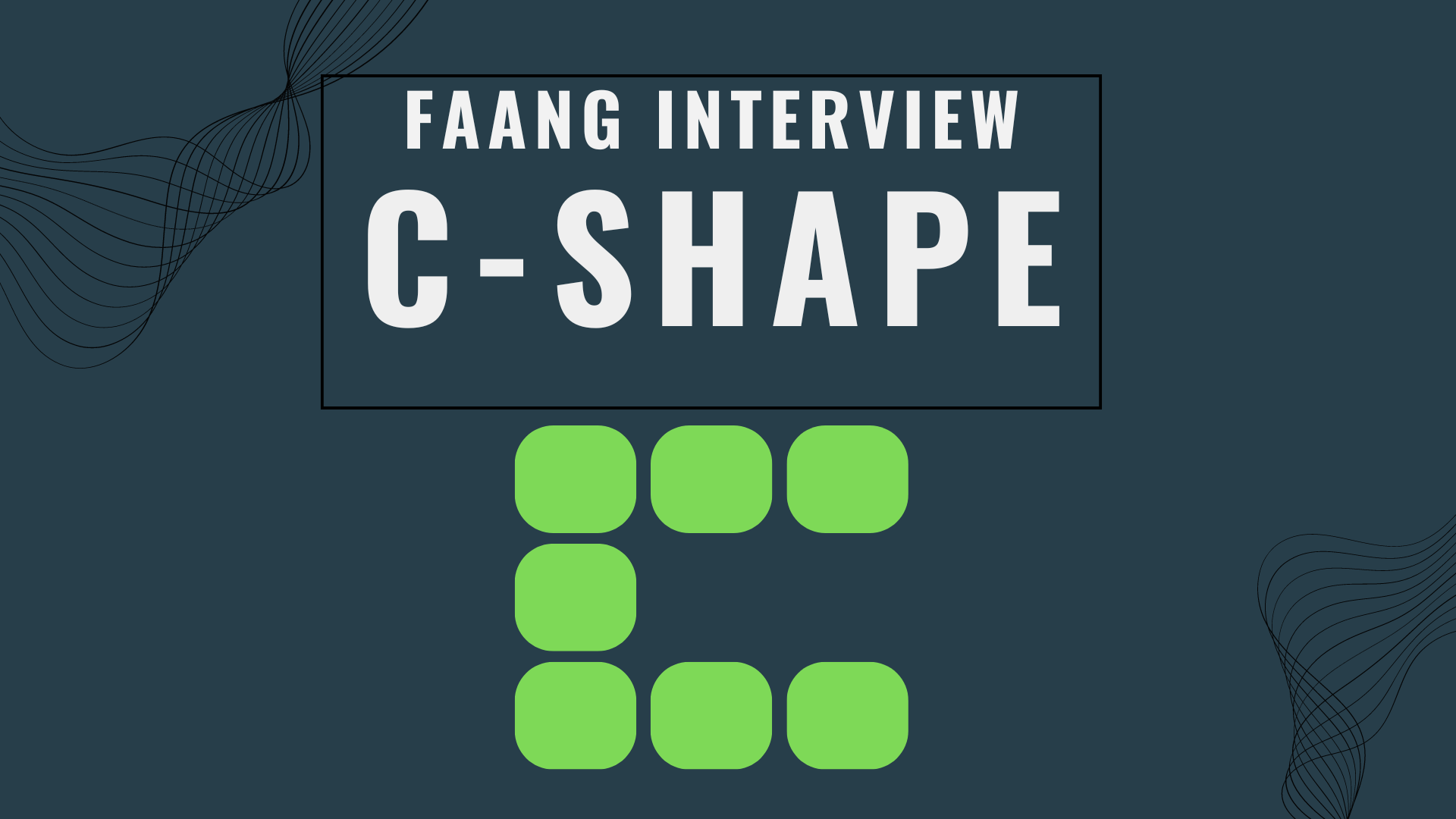Tackling the C-Shape Challenge: A FAANG interview staple
 Dominick J. Monaco
Dominick J. Monaco
Kicking things off!
Welcome to the first entry in my new blog post series, where I'm taking a leaf out of Brian Douglas's hat from OpenSauced. I'll be diving into the world of LeetCode style interview questions, sharing my experiences and solutions from problems I've seen across the interview process. Today, we're kicking off with a common front-end React problem I encountered in a recent FANG interview: the C-shape problem.
What's the C-Shape Problem?
The C-shape problem is deceptively simple at first glance. It's a coding challenge where you're tasked with replicating the functionality of a web layout designed in the shape of a 'C'. There are seven clickable boxes arranged with three in the top row, one aligned to the left in the middle, and three more at the bottom. On click, each button's background is changed, and once all the boxes are clicked they return to their un-selected state one-by-one in the order they were clicked. It's a classic front-end conundrum that's trickier than it looks.

Breaking Down the Code
Let's walk through the code and break it down into manageable steps. We'll start by setting up the basic layout.
The Layout
Here's the basic structure of our JSX. If you look closely, you'll notice something interesting. The <Box/> components are not native, they are custom components! We''ll touch on that later, what's important now is that box components have two css classes that interact with them: .box and .isClicked
return (
<div className="container">
<div className="row">
<Box
id={1}
onClick={handleBoxClick}
isClicked={clickedBoxes.includes(1)}
/>
<Box
id={2}
onClick={handleBoxClick}
isClicked={clickedBoxes.includes(2)}
/>
<Box
id={3}
onClick={handleBoxClick}
isClicked={clickedBoxes.includes(3)}
/>
</div>
<div className="row">
<Box
id={4}
onClick={handleBoxClick}
isClicked={clickedBoxes.includes(4)}
/>
</div>
<div className="row">
<Box
id={5}
onClick={handleBoxClick}
isClicked={clickedBoxes.includes(5)}
/>
<Box
id={6}
onClick={handleBoxClick}
isClicked={clickedBoxes.includes(6)}
/>
<Box
id={7}
onClick={handleBoxClick}
isClicked={clickedBoxes.includes(7)}
/>
</div>
</div>
);
CSS
Here's our CSS file. We have a handful of classes we're worrying about:
.container for defining how all of our rows look
.row for defining how each row is styled
.box sets the width, height, and border for each box; among other things.
.isClicked is a class thats added into our
<Box>components once selected.
.container {
display: flex;
flex-direction: column;
align-items: flex-start;
justify-content: center;
height: 100vh;
padding: 2rem;
}
.row {
display: flex;
margin-bottom: 1rem;
}
.box {
width: 5rem;
height: 5rem;
border: 1px solid #9a1e1e;
cursor: pointer;
transition: background-color 0.3s ease;
margin-right: 1rem;
}
.clicked {
background-color: #3b82f6;
}
Managing Clicks with State
State is crucial here—it helps us keep track of which boxes have been clicked and manage the component's resetting to its default state.
Here we define two state variables. The former is defined as an array, the latter as a boolean. We'll be storing the boxes that are clicked, in order by their respective id's, here in setClickedBoxes. The other state variable we have is isResetting, which is basically an on/off switch. Did we click all the boxes? Do we want to reset all the selected boxes? Resetting is true.
//defining our state variables
const [clickedBoxes, setClickedBoxes] = useState([]);
const [isResetting, setIsResetting] = useState(false);
Handling a Click
Below is our logic for handling a click event. Lets break it down👇
//defining our state variables
const [clickedBoxes, setClickedBoxes] = useState([]);
const [isResetting, setIsResetting] = useState(false);
//defining the function that handles our 'clicking' logic
const handleBoxClick = (boxId) => {
if (isResetting) return;
setClickedBoxes((prev) => {
const newClickedBoxes = [...prev, boxId];
if (newClickedBoxes.length === 7) {
setIsResetting(true);
}
return newClickedBoxes;
});
};
Above we have:
a condition to check if
isResettingis true.If
isResettingis true, we don't track any clicks.We define a new variable
newClickedBoxesin our setting logicwe add in the clicked elements
idto our existing array of clicked boxesIf
newClickBoxes.lengthequals seven, we've clicked all the boxes, and it's time to reset.
We declare that isResetting is true and return our array of boxId's. How do we handle the logic for when we reset our boxes to our initial, blank state though? That's where the useEffect hook comes in.
The Magic of useEffect
We can leverage useEffect kick off the resetting process. When isResetting is true, we define a timeouts variable. This variable maps our clicked boxes, taking the box ID and its index. We then set a timeout for each box, filtering through our setClickBoxes array by ID. If the index equals clickBox.length - 1, we're done resetting and set isResetting to false. We've set the timeout to the current index multiplied by 300 milliseconds, creating a staggered reset effect.
useEffect(() => {
if (isResetting) {
const resetDelay = 200;
const timeouts = clickedBoxes.map((id, index) =>
setTimeout(() => {
setClickedBoxes((prev) => prev.filter((boxId) => boxId !== id));
if (index === clickedBoxes.length - 1) setIsResetting(false);
}, resetDelay * (index + 1))
);
return () => {
timeouts.forEach(clearTimeout);
};
}
}, [isResetting, clickedBoxes]);
For cleanup, we have an anonymous function that clears each timeout. The dependency array for this effect includes isResetting and clickBoxes.
Crafting the Box Component
The final piece of the puzzle is the box component. It takes an object with an ID, an onClick handler, and an isClicked state. We dynamically define the class name using a template literal and a ternary operator. If isClicked is true, we append the isClicked class; if not, we leave it be. This allows us to dynamically render CSS based on the isClicked state.
const Box = ({ id, onClick, isClicked }) => (
<div
className={`box ${isClicked ? "clicked" : ""}`}
onClick={() => onClick(id)}
/>
);
To further optimize, we could use the useCallback hook to memoize the box component, ensuring it only re-renders when necessary.
Optimization with useCallback.
useCallback & Memoize
We can refactor our useEffect logic using the React hook useCallback and memoize the box component to ensure it won't needlessly re-render. Not a strict must for this particular code, but it showcases you understand how to leverage react hooks to handle state more efficiently.
Here we can leverage useCallback in the handleBoxClick function. We pass in isResetting into the dependency array so that a re-render of any components using handleBoxClick is triggered only when isResseting changes value (from false to true).
const handleBoxClick = useCallback((boxId) => {
const handleBoxClick = useCallback((boxId) => {
if (isResetting) return;
setClickedBoxes((prev) => {
const newClickedBoxes = [...prev, boxId];
if (newClickedBoxes.length === 7) {
setIsResetting(true);
const resetDelay = 200;
newClickedBoxes.forEach((id, index) => {
setTimeout(() => {
setClickedBoxes((prev) => prev.filter((boxId) => boxId !== id));
if (index === 6) setIsResetting(false);
}, resetDelay * (index + 1));
});
}
return newClickedBoxes;
});
}, [isResetting]);
}, [isResetting]);
We can also reproduce similar functionality with our Box component. Using React.memo ensures that box components only trigger a re-render when their props, in this case id; onClick; or isClicked , change. While this see's little effect in our coding test, if you imagine a box component in a large repo, where it can be re-used in potentially many places and inside many other components or containers, ensuring that the <Box/> component and handleClick function re-render only when relevant they're supposed to is good, and scalable, implementation. It saves you, and many others, time later on.
const Box = React.memo(({ id, onClick, isClicked }) => (
// Component JSX
));
Wrapping Up
And there you have it—a step-by-step breakdown of tackling the C-shape problem in React. It's a great example of how a simple task can teach you a lot about state management, effects, and component rendering. Stay tuned for more posts as I continue to explore and implement interview questions, sharing my insights along the way.
Don't forget to check out the code here: CodeSandbox.
Happy coding!
Subscribe to my newsletter
Read articles from Dominick J. Monaco directly inside your inbox. Subscribe to the newsletter, and don't miss out.
Written by

Dominick J. Monaco
Dominick J. Monaco
I am a Software Engineer, Americorp Alumni, and an avid conservationist. Very interested in exploring solutions to aid in saving the planet, or at least just the bees.